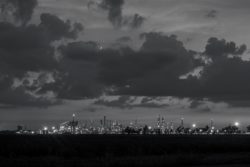Enigmatic Stream
Photographer Richard Sexton captures the complexities of the Mississippi’s industrial corridor
Published: August 30, 2019
Last Updated: December 1, 2019

The Historic New Orleans Collection
Richard Sexton, Moonrise over Motiva oil refinery, from Highway 70 near Donaldsonville, 2015. Copyright Richard Sexton, 2015.
Oil refineries and petrochemical plants loom largest here, but there are also power plants, granaries, sugar refineries, bridges, levees, spillways, and more. Some of these sites are as old now as the plantation houses were when artists and photographers first romanticized them as relics of a bygone era. Time has only intensified the myopia that frames plantation life as a pastoral idyll, given that human slavery was its sustenance, and a comparable burden haunts today’s industrial landscape. The same plants that drive Louisiana’s economy cannot be disentangled from the consequences of global warming, toxic waste, and society’s unbridled consumption of vital, nonrenewable natural resources.
Few documentations have focused on this landscape as a historical and evolving one. We, as a public, intellectually understand heavy industry’s importance, view its power with awe, and at the same time fear and loathe its existence. I can’t cast myself as a dispassionate witness. I am intrigued by the unrelenting human effort to mine the river’s resources in the face of floods, hurricanes, pestilence, civil war, and industrial disasters. I am also intrigued by the industrial design of this landscape, unfettered by aesthetic issues, artistic aspiration, or pretension—driven purely by function. In its juxtaposition of elements, the landscape is filled with incongruity and mystery.
The human exploitation of a capricious river and its fertile delta has precipitated an extraordinary industrial infrastructure, which has formed an equally extraordinary contrast with the rural landscape around it. With Enigmatic Stream, I have tried, as with all things I photograph, to portray it deliberately, purposefully, eloquently, and, above all else, honestly.
Richard Sexton is a fine art and media photographer whose work has been published and exhibited worldwide. His photographs are included in the permanent holdings of many institutions and have been featured in Abitare, Archetype, Photographer’s Forum, View Camera, and other magazines. Enigmatic Stream is the 14th book he has authored, coauthored, or photographed.
